Collect data Like a Pro. What is data collection
- Collect data Like a Pro. What is data collection
- Comparing data vocabulary. Exercise: Explaining and comparing a chart
- Data Tools. Как установить SQL Server Data Tools (SSDT) и что это такое
- Types of data analysis. What Is Data Analysis?
- Data analysis methods. What is the difference between quantitative and qualitative data?
- Data-driven culture. What is data-driven culture?
Collect data Like a Pro. What is data collection
Data collection is the process of gathering and categorizing relevant information that can then be used to make decisions about specific situations. As you can tell from the definition, it’s not a process that’s only for business.
In every aspect of our lives, we go through the process of data collection. For example, if you want to move to a new city, you collect as much data as you can. When assessing a new job offer, you collect data about the company’s growth, salary scale, etc.
Moreover, data collection should imply a kind of summarising information with insights you’ve collected. It helps to understand all the main points about the subject in question. To add some cool design elements to this process, you can use one-pager templates .
By analyzing the data you’ve gathered, you can uncover patterns, trends, and correlations that provide valuable insights. These insights guide informed decision-making and enable you to make well-informed choices based on evidence.
Amidst the digital age, data collection has taken on new dimensions. In essence, data collection has transcended its conventional boundaries, becoming a driving force behind technological innovation and societal progress.
In a business setting, the data collection process and methods are more formal and tend to yield better outcomes as a result. That’s in part due to a clear delineation between the types of data that can be collected.
Within this stage, data processing assumes a pivotal role, orchestrating the orchestration, refinement, and translation of amassed data into a format that’s both pragmatic and navigable.
The modern landscape sees businesses and institutions capitalizing on data’s potential, propelling data processing techniques to unprecedented sophistication.
This evolution empowers the extraction of concealed patterns and invaluable insights, fundamentally reshaping the landscape of decision-making and issue resolution across diverse industries.
Data collection is the process of gathering and categorizing relevant information that can then be used to make decisions about specific situations. As you can tell from the definition, it’s not a process that’s only for business.
In every aspect of our lives, we go through the process of data collection. For example, if you want to move to a new city, you collect as much data as you can. When assessing a new job offer, you collect data about the company’s growth, salary scale, etc.
Data collection should imply a kind of summarizing information with insights you’ve collected. It helps to understand all the main points about the subject in question. To add some cool design elements to this process, you can use one-pager templates.
By analyzing the data you’ve gathered, you can uncover patterns, trends, and correlations that provide valuable insights. These insights guide informed decision-making and enable you to make well-informed choices based on evidence.
Amidst the digital age, data collection has taken on new dimensions. In essence, data collection has transcended its conventional boundaries, becoming a driving force behind technological innovation and societal progress.
In a business setting, the data collection process and methods are more formal and tend to yield better outcomes as a result. That’s in part due to a clear delineation between the types of data that can be collected.
Within this stage, data processing assumes a pivotal role, orchestrating the orchestration, refinement, and translation of amassed data into a format that’s both pragmatic and navigable.
Comparing data vocabulary. Exercise: Explaining and comparing a chart
Using the both context and the chart, try to guess what the meaning of the words/phrases in bold are. Then do the quiz at the end to check if you are right.
Manager: "The above chart shows the monthly food and drink sales in the Keighley cinema during 2010. The chart shows unit sales. As you can see , there are three lines on the chart. The sales of popcorn is represented by the green line. The blue line represents drinks. The red line represents ice cream. The chart demonstrates that drinks are by far the biggest type of food and drink sold in the cinema throughout the year.
The chart also shows that there is a correlation between popcorn sales and drinks. When popcorn sales rise, there is also a rise in the sales of drinks. This trend supports the theory that people drink more when they eat food that contains a lot of salt. During the summer, sales of drinks and popcorn showed a steady increase, by contrast , unit sales of ice cream actually fell slightly. In fact, sales of ice cream fell from April to July, falling from 1025 units to 821 units per month respectively . These result would seem to contradict the idea that people consume more ice cream during summer, because as we can see from the results there is no link .
Data Tools. Как установить SQL Server Data Tools (SSDT) и что это такое
Приветствую всех посетителей сайта Info-Comp.ru! В этом материале мы рассмотрим процесс установки SQL Server Data Tools (SSDT), а также поговорим о том, что это за инструмент и для чего он предназначен.
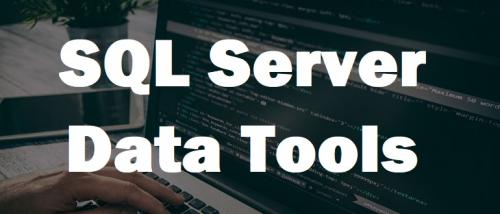
Что такое SQL Server Data Tools
SQL Server Data Tools ( SSDT) – это отдельный компонент (рабочая нагрузка) Visual Studio, который предназначен для разработки реляционных баз данных SQL Server.
Иными словами, SSDT – это своего рода альтернатива SQL Server Management Studio (SSMS), но полностью интегрированная в среду Visual Studio. При этом, конечно же, функционал и возможности SSDT отличаются от SSMS, более того, назначение SSDT немного отличается от того, для чего создана SSMS.
Если SSMS создана для разработки и сопровождения баз данных, а также для администрирования SQL Server, т.е. среда SSMS — это некое комплексное решение по работе с SQL Server, то SSDT создан для проектной разработки баз данных с применением всех возможностей и преимуществ Visual Studio, а также с использованием привычного для разработчиков приложений интерфейса и функционала.
Таким образом, SQL Server Data Tools предназначен для разработчиков, создающих приложения в среде Visual Studio.
Возможности и особенности SQL Server Data Tools
Разработка баз данных SQL Server и SQL Azure
Охват всех этапов разработки базы данных
Знакомый интерфейс и функционал Visual Studio
Можно работать как с проектом базы данных, так и с подключенным экземпляром базы данных
Представление объектов базы данных, как в SSMS
Конструктор таблиц с графическим интерфейсом
Навигация по коду
Технология IntelliSense
Сборка и отладка
Рефакторинг баз данных
Декларативное внесение изменений в редакторе Transact-SQL
Установка SQL Server Data Tools
Мы выяснили, что SQL Server Data Tools – это отдельная рабочая нагрузка среды Visual Studio. Поэтому, чтобы установить SQL Server Data Tools, нужна сама среда Visual Studio.
Если среда у Вас уже установлена, Вам необходимо добавить рабочую нагрузку « Хранение и обработка данных» .
Если среда не установлена, Вам необходимо установить Visual Studio и во время установки отметить рабочую нагрузку « Хранение и обработка данных» .
Автономного установщика SQL Server Data Tools для Visual Studio 2019, к сожалению, не предусмотрено.
Рассмотрим ситуацию, когда Visual Studio уже установлена и нам необходимо установить SQL Server Data Tools.
Запускаем Visual Studio Installer
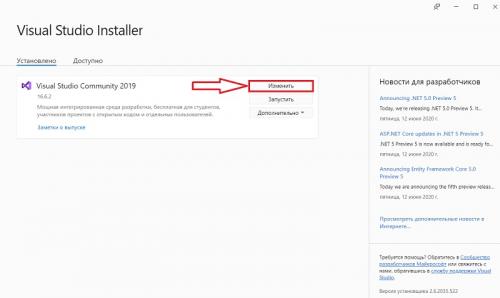
Отмечаем рабочую нагрузку
Далее, отмечаем рабочую нагрузку, которую мы хотим установить, в данном случае нам нужна рабочая нагрузка « Хранение и обработка данных».
После чего нажимаем кнопку «Изменить» .
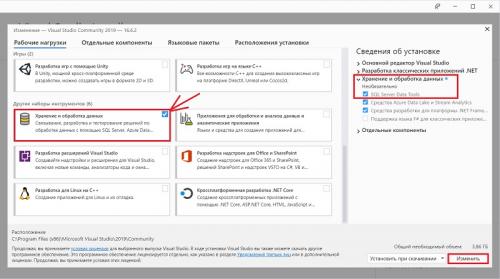
В итоге начнётся процесс загрузки и установки всех необходимых компонентов.
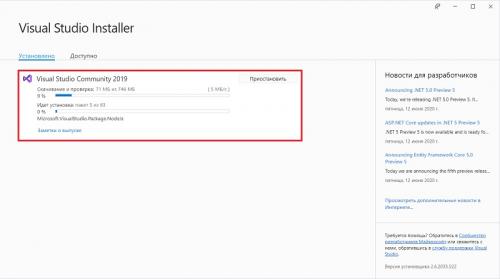
Когда данный процесс будет завершен, отобразится стандартное окно данного приложения.

Создание проекта базы данных в SQL Server Data Tools
После установки SQL Server Data Tools у Вас появится весь функционал, входящий в эту рабочую нагрузку, включая возможность создания специального проекта для баз данных.
Давайте для примера создадим такой проект.
Запускаем Visual Studio и выбираем «Создание проекта» .
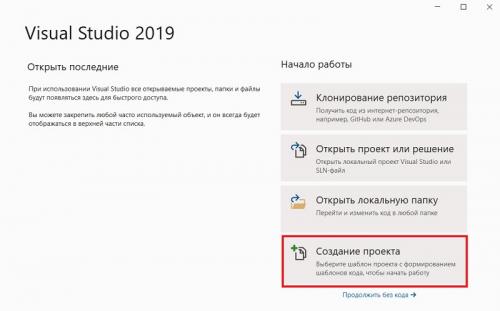

Вводим название проекта, указываем расположение проекта, а также задаем имя решения.
Types of data analysis. What Is Data Analysis?
The systematic application of statistical and logical techniques to describe the data scope, modularize the data structure, condense the data representation, illustrate via images, tables, and graphs, and evaluate statistical inclinations, probability data, and derive meaningful conclusions known as Data Analysis. These analytical procedures enable us to induce the underlying inference from data by eliminating the unnecessary chaos created by its rest. Data generation is a continual process; this makes data analysis a continuous, iterative process where the collection and performing data analysis simultaneously. Ensuring data integrity is one of the essential components of data analysis.
There are various examples where data analysis is used, ranging from transportation, risk and fraud detection, customer interaction, city planning healthcare, web search, digital advertisement, and more.
Considering the example of healthcare, as we have noticed recently that with the outbreak of the pandemic, Coronavirus hospitals are facing the challenge of coping up with the pressure in treating as many patients as possible, considering data analysis allows to monitor machine and data usage in such scenarios to achieve efficiency gain.
Before diving any more in-depth, make the following pre-requisites for proper Data Analysis:
- Ensure availability of the necessary analytical skills
- Ensure appropriate implementation of data collection methods and analysis.
- Determine the statistical significance
- Check for inappropriate analysis
- Ensure the presence of legitimate and unbiased inference
- Ensure the reliability and validity of data, data sources, data analysis methods, and inferences derived.
Data analysis methods. What is the difference between quantitative and qualitative data?
How you analyze your data depends on the type of data you’re dealing with— quantitative or qualitative . So what’s the difference?
Quantitative data is anything measurable , comprising specific quantities and numbers. Some examples of quantitative data include sales figures, email click-through rates, number of website visitors, and percentage revenue increase. Quantitative data analysis techniques focus on the statistical, mathematical, or numerical analysis of (usually large) datasets. This includes the manipulation of statistical data using computational techniques and algorithms. Quantitative analysis techniques are often used to explain certain phenomena or to make predictions.
Qualitative data cannot be measured objectively , and is therefore open to more subjective interpretation. Some examples of qualitative data include comments left in response to a survey question, things people have said during interviews, tweets and other social media posts, and the text included in product reviews. With qualitative data analysis, the focus is on making sense of unstructured data (such as written text, or transcripts of spoken conversations). Often, qualitative analysis will organize the data into themes—a process which, fortunately, can be automated.
Data analysts work with both quantitative and qualitative data , so it’s important to be familiar with a variety of analysis methods. Let’s take a look at some of the most useful techniques now.
Data-driven culture. What is data-driven culture?
Before we jump into making a resilient data-driven culture, let’s ensure we know precisely.
Data-driven decision-making is a process that relies on data and analytics rather than intuition or experience. Businesses that successfully adopt it guide their actions with facts, not assumptions. This allows them to avoid costly mistakes and pursue opportunities with confidence.
Adopting a data-driven culture is not about randomly collecting data and then analyzing it afterward. It’s a proactive approach in which data is collected with specific decisions in mind. A data-driven workplace will find that it cannot function without a constant flow of information.
Consider how a data outage would affect your workplace. Would operations be able to continue for a few hours, days, or even weeks? How would this lack of information affect different departments within your organization? These questions are a great litmus test to see if your efforts to cultivate a data-driven culture are finding success.
The advantages of a data-driven culture
It will be a lot of work to integrate data fully into your business, so it is helpful to remember the return on this investment . Here are some of the many benefits of instituting a data-driven culture.
Improved customer satisfaction: When you have a clear understanding of what your customers want and need, it’s easier to give it to them.
Better decision-making: Data also allows you to see things that you would otherwise miss, giving you a more complete picture of your situation. You’ll be able to make confident decisions quickly because you can see all the factors involved.
Reduced waste: Collecting and analyzing data can help you identify areas where you’re wasting money. Once you know where the extra spending is occurring, you can take steps to reduce or eliminate it.
New growth opportunities: By targeting your marketing and product development efforts to areas where you know there is demand, you can increase your revenue without having to spend a lot of extra money.
Increased transparency: Data-driven cultures are typically more transparent than those that rely on intuition or experience. This will allow you to build trust with your employees and customers by being open about how you make decisions.
Elevated teamwork: When everyone understands concepts like coding and quantitative topics, they can operate as one entity moving towards your goals.